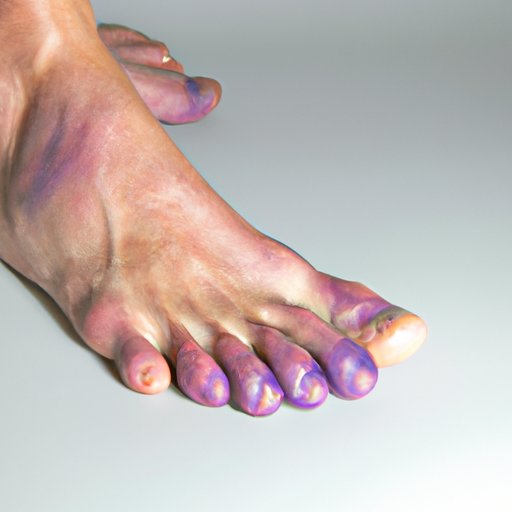Introduction
Have you ever looked down at your feet and wondered, “why are my feet purple?” While it may seem like a harmless cosmetic issue, purple discoloration in the feet can actually be an indicator of an underlying health issue. In this article, we will explore the potential causes of purple feet, including medical conditions, contusions, and medication side effects. We’ll also provide tips and advice for preventing and managing purple feet based on your unique situation.
The Color of Your Feet: What Purple Feet Could Be Telling You About Your Health
Purple feet can be a sign of poor circulation, which can be caused by medical conditions such as diabetes, Raynaud’s syndrome, or peripheral artery disease. In these cases, the purple discoloration may be accompanied by other symptoms such as numbness or tingling.
If you are experiencing purple feet due to poor circulation, there are several steps you can take to improve blood flow. For example, regular exercise, quitting smoking, and managing your weight can all improve circulation. Elevating your feet when you’re sitting or lying down can also help to reduce swelling and improve blood flow.
It’s important to note that persistent or severe purple discoloration should prompt a visit to the doctor. In some cases, medication or surgery may be necessary to treat the underlying cause of poor circulation.
Cold Weather Toes: Why Your Feet Turn Purple in the Winter
If you notice your feet turning purple in response to cold weather, it may be due to a condition called Raynaud’s phenomenon. This condition causes blood vessels in the feet and hands to narrow in response to cold or stress, leading to reduced blood flow and discoloration.
To prevent purple feet in the winter, it’s important to keep your feet warm and dry. This may mean investing in warm socks or shoes, or using foot warmers or a heated footrest. You may also find that maintaining a healthy weight and exercising regularly can help to improve circulation and prevent Raynaud’s symptoms.
Beyond Just a Bruise: Understanding Contusion-Related Purple Feet
If you’ve recently suffered a blow or trauma to your foot, you may notice discoloration and swelling around the affected area. This is known as a contusion, and it can cause the surrounding tissues to become inflamed and discolored.
In most cases, contusions will resolve on their own with rest, ice, elevation, and pain medication as needed. However, if you experience severe or recurring contusions in your feet, it’s important to seek medical attention to ensure there are no underlying medical issues contributing to the issue.
Living with Raynaud’s: Coping with the Purple Foot Phenomenon
If you have been diagnosed with Raynaud’s syndrome, it’s important to work closely with your doctor to manage the condition and reduce the risk of purple feet. This may mean taking steps to keep your feet warm and dry, managing stress levels, and taking medications as prescribed.
In addition to medical interventions, there are lifestyle changes you can make to reduce the risk of Raynaud’s symptoms. For example, quitting smoking, eating a healthy diet, and staying active can all help to improve circulation and reduce the frequency and severity of Raynaud’s symptoms.
Medication Side Effects: Could Your Purple Feet Be a Symptom?
If you’re taking medication, it’s important to be aware of potential side effects that may cause purple discoloration in your feet. For example, certain chemotherapy drugs, blood thinners, or medications used to treat high blood pressure may cause peripheral neuropathy, a condition that can lead to discoloration and numbness in the feet.
If you suspect that your medication may be causing purple discoloration in your feet, it’s important to speak with your doctor to discuss your options. In some cases, switching to a different medication or adjusting the dosage may resolve the issue.
The Connection Between Exercise and Purple Feet: What Athletes Need to Know
If you’re an athlete or regularly engage in high-impact exercise, you may notice purple discoloration in your feet after a workout. This is often due to increased blood flow and inflammation in the area.
To prevent purple feet during workouts, it’s important to wear supportive, well-fitted shoes and to take breaks as needed to allow your feet to rest and recover. You may also find that stretching and massaging your feet after exercise can help to improve circulation and reduce swelling.
Conclusion
While purple feet may seem like a minor issue, it can actually be an indicator of an underlying health issue or circulation problem. By understanding the potential causes of purple feet and taking steps to prevent or manage the condition, you can maintain healthy, happy feet. Remember to speak with your doctor if you experience persistent or severe purple discoloration in your feet, as this may be a sign of an underlying medical issue that requires treatment.
